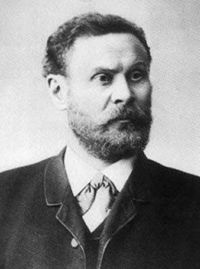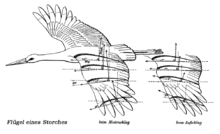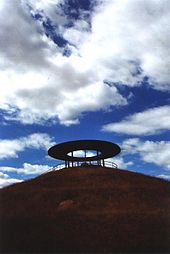- Otto Lilienthal
-
Otto Lilienthal 
Otto LilienthalBorn 23 May 1848
Anklam, Province of PomeraniaDied 10 August 1896 (48 years old)
BerlinCause of death Glider crash Resting place Berlin Nationality Prussian, German Occupation Engineer Known for Successful gliding experiments Spouse Agnes Fischer Relatives Gustav Lilienthal, brother Otto Lilienthal (May 23, 1848 – August 10, 1896) was a German pioneer of human aviation who became known as the Glider King. He was the first person to make well-documented, repeated, successful gliding flights. He followed an experimental approach established earlier by Sir George Cayley. Newspapers and magazines published photographs of Lilienthal gliding, favorably influencing public and scientific opinion about the possibility of flying machines becoming practical.
Contents
Early life
Lilienthal was born in Anklam, Pomerania Province, Prussia to a family of Swedish origin. He attended the grammar school in Anklam, and also studied the flight of birds with his brother Gustav (1849–1933),[1] fascinated by the idea of manned flight. Lilienthal and his brother made strap-on wings, but failed in their attempts to fly. He then attended the regional technical school in Potsdam for two years and trained at the Schwarzkopf Company before becoming a professional design engineer. He would later attend the Royal Technical Academy in Berlin.
In 1867 he began his experiments on the force of air in earnest, interrupted when he volunteered to serve in the Franco-Prussian War. As a staff engineer in various engineering companies, he received his first patent for a mining machine. He married Agnes Fischer, daughter of a deputy in 1878. Five years later, he founded his own company to make boilers and steam engines. Lilienthal published his famous book Birdflight as the Basis of Aviation in 1889.
Experiments in flight
Lilienthal's greatest contribution was in the development of heavier-than-air flight. He made his flights from an artificial hill he built near Berlin and from natural hills, especially in the Rhinow region.
A sketch toward a second hang glider in about 1891 involved a triangle control frame with a complex basebar that would lead to lower double kingposts while the apex of the triangle would serve as a single kingpost;[2] his filing of a U.S. Patent in 1894 directed pilots to grip the "bar" for carrying and flying the hang glider.[3] The A-frame of Percy Pilcher and Otto Lilienthal echoes in today's control frame for hang gliders and ultralight trike aircraft. Working in conjunction with his brother Gustav, he made over 2,000 flights in gliders of his design starting in 1891 with his first glider version, the Derwitzer, until his death in a gliding crash in 1896.
He could use the updraft of a 10 m/s wind against a hill to remain stationary with respect to the ground, shouting to a photographer on the ground to manoeuvre into the best position for a photo.
 Mechanics of White Stork flight in his Der Vogelflug als Grundlage der Fliegekunst (1889)
Mechanics of White Stork flight in his Der Vogelflug als Grundlage der Fliegekunst (1889)
Lilienthal did research in accurately describing the flight of birds, especially storks, and used polar diagrams for describing the aerodynamics of their wings. He made many experiments in an attempt to gather reliable aeronautical data.
His gliders were controlled by changing the centre of gravity by shifting his body, much like modern hang gliders. However they were difficult to maneuvre and had a tendency to pitch down, from which it was difficult to recover. One reason for this was that he held the glider by his shoulders, rather than hanging from it like a modern hang glider. Only his legs and lower body could be moved, which limited the amount of weight shift he could achieve.
Lilienthal made many attempts to improve stability with varying degrees of success. These included making a biplane which halved the wing span for a given wing area, and by having a hinged tail-plane that could move upwards to make the flare at the end of a flight easier. He speculated that flapping wings of birds might be necessary and had begun work on such a powered aircraft.
While his lifelong pursuit was flight, he was also an inventor and devised a small engine that worked on a system of tubular boilers. His engine was much safer than the other small engines of the time. This invention gave him the financial freedom to focus on aviation. His brother Gustav (1849–1933) was living in Australia at the time, and Lilienthal did not engage in aviation experiments until his brother's return in 1885.
Worldwide notice
Reports of Lilienthal's flights spread in Germany and elsewhere, with photographs appearing in scientific and popular publications. Among the those who photographed him were pioneers such as Ottomar Anschütz and American physicist Robert Williams Wood. He soon became known as the 'father of flight' as he had successfully controlled a heavier than air aircraft in sustained flight.
Lilienthal was a member of the Verein zur Förderung der Luftschifffahrt, and regularly detailed his experiences in articles in its journal, the Zeitschrift für Luftschifffahrt und Physik der Atmosphäre, and in the popular weekly publication Prometheus. These were translated in the United States, France and Russia. Many people from around the world came to visit him, including Samuel Pierpont Langley from the United States, Russian Nikolai Zhukovsky, Englishman Percy Pilcher and Austrian Wilhelm Kress. Zhukovsky wrote that Lilienthal's flying machine was the most important invention in the aviation field. Lilienthal corresponded with many people, among them Octave Chanute, James Means, Alois Wolfmüller and other flight pioneers.
Final flight
During a flight on 9 August 1896, Lilienthal's glider stalled and he fell from a height of 17 m (56 ft), breaking his spine. He died in Berlin the following day. He was buried at Lankwitz Cemetery in Berlin.
Legacy
Lilienthal's research was well known to the Wright brothers, and they credited him as a major inspiration for their decision to pursue manned flight. However, they abandoned his aeronautical data after two seasons of gliding and began using their own wind tunnel data.[4]
Of all the men who attacked the flying problem in the 19th century, Otto Lilienthal was easily the most important. ... It is true that attempts at gliding had been made hundreds of years before him, and that in the nineteenth century, Cayley, Spencer, Wenham, Mouillard, and many others were reported to have made feeble attempts to glide, but their failures were so complete that nothing of value resulted.—Wilbur Wright [5]Berlin's busiest airport, Berlin Tegel "Otto Lilienthal" Airport, is named after him.
In September 1909 Orville Wright was in Germany making demonstration flights at Tempelhof aerodrome. He paid a call to Lilienthal's widow and on behalf of himself and Wilbur paid tribute to Lilienthal for his influence in aviation and on their own initial experiments in 1899.
Lilienthal in fiction
- Lilienthal plays a major part (in absentia) in Theodora Goss's short story "The Wings of Meister Wilhelm," nominated for a World Fantasy Award and published in her anthology In the Forest of Forgetting.
- H.G. Wells in his 1898 science-fiction story The War of the Worlds, near the end of chapter 2, book 2, refers to "our Lilienthal soaring machines," explaining that these and other human technology must seem rudimentary when compared to the story's invading Martians’.
- H.G. Wells mentions Lilienthal at the beginning of Chapter XVI of "When the Sleeper Wakes" (1899), calling him "the aerial proto-martyr". The reference is missing from the revised later edition entitled "The Sleeper Wakes" (1910).
- Lilienthal appears momentarily as an idol for the main character, Conor, in Eoin Colfer's Airman.
- Lilienthal is mentioned in Edward D. Hoch's short story "The Flying Man".
- A fictional characterization of Lilienthal was resurrected as an evil clone in the Japanese Read or Die (2001) novels, anime, and manga.
- Lilienthal's "great grandson" appears in the Spanish short story, "El Sueño de Otto."
- A Lilienthal glider serves as a major plot element in Paul Gazis' Webserial "The Airship Flying Cloud, R-505".[6]
- Lilienthal is mentioned as a "great scientist" in the video game Civilization Revolution.
Gallery
See also
- Lilienthal Gliding Medal
- Aviation history
- Albrecht Berblinger
- Abbas Ibn Firnas
- George Cayley
- Jean-Marie Le Bris
- John Joseph Montgomery
- German inventors and discoverers
References
- Notes
- ^ ENCYCLOPEDIA OF TRANSPORTATION Rand-McNally c. 1977
- ^ Flying Machines: Sketch toward his second hang glider is included.[not in citation given]
- ^ FLYING-MACHINE OTTO LILIENTHAL
- ^ Crouch, ch. 16, "Tunnel Vision," pp. 226-28
- ^ Aero Club of America Bulletin, Sept. 1912
- ^ The Airship Flying Cloud, R-505
- Bibliography
- Lilienthal, Otto (1911). Birdflight as the Basis of Aviation. reprinted 2001: ISBN 0-938716-58-1 (Translation from German edition, Berlin 1889: Der Vogelflug als Grundlage der Fliegekunst reprinted 2003: ISBN 3-9809023-8-2
- Crouch, Tom D (1989). The Bishop's Boys: A Life of Wilbur and Orville Wright. W. W. Norton & Company. ISBN 0-393-30695-X
External links
- Lilienthal Museum
- Lilienthal's appendix From Chanute's book Progress in Flying Machines 1893.
- Movies and simulations
- Biography / family tree of Otto Lilienthal
- Otto Lilienthal. (n.d.). Retrieved 2009, from Otto Lilienthal Biography: http://www.answers.com/topic/otto-lilienthal
- Otto Lilienthal Biography ( 1848–1896). (n.d.). Retrieved 2009, from www.madehow.com: http://www.madehow.com/inventorbios/29/Otto-Lilienthal.html
Categories:- 1848 births
- 1896 deaths
- People from Anklam
- 19th-century aviation
- Aviation inventors
- Aviation pioneers
- Aviation history of Germany
- Aviation accidents and incidents in 1896
- Glider pilots
- Aviators killed in aviation accidents or incidents
- German inventors
- German aviators
- People from the Province of Pomerania
- Victims of aviation accidents or incidents in Germany
Wikimedia Foundation. 2010.





